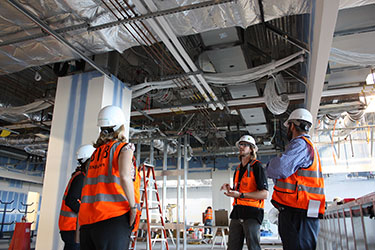|
Subscribe / Renew |
|
|
Contact Us |
|
| ► Subscribe to our Free Weekly Newsletter | |
| home | Welcome, sign in or click here to subscribe. | login |
Construction
| |
 |
May 11, 2023
What does it take to convert offices to biotech lab space?
BNBuilders

Gates
|
In many of the premier life science markets, developers are regularly acquiring office buildings and converting them to lab spaces.
However, all buildings are not created equal, and while many have the potential to house life science space, it may prove cost prohibitive or impractical without consideration of certain factors. Conversions can range from full demolition and renovation to minor modifications supporting lab-specific processes. Major considerations include the building site, structure, enclosure, elevators, and MEPF (mechanical/HVAC, electrical, plumbing, and fire protection systems.)
SITE CONSIDERATIONS
Life science tenants often require specific site features atypical of traditional office developments. For example, a loading dock and access drive aisle for shipping and receiving are essential. A life science tenant will receive much larger and more frequent deliveries than a typical tenant. Therefore, the drive aisle and loading area must accommodate large trucks with direct access to the dock and away from the public entrance.
In conjunction with the need for an appropriately sized loading dock, life science users often require a service or freight elevator, which has the size and capacity to move large, heavy equipment. Other site considerations include appropriate waste utilities, electrical service sized to accommodate the load of a life science tenant, outdoor amenity areas, and utility yards for backup generators and central utility plants.
STRUCTURE
Key structural considerations include the capacity of the floors to support large lab equipment, a roof structure capable of supporting new mechanical units, slab openings for vertical utilities, and potential structural upgrades.
The buildings we evaluate for office-to-lab conversions consist of various structure types, from tilt-up to cast-in-place concrete to structural steel. Since they were built to house office spaces, these buildings are typically not designed to accommodate lab floor loading requirements and do not meet the vibration criteria required by life science equipment. Therefore, working closely with a structural engineer to determine the most efficient and cost-effective method for improving the structure is imperative.
For example, evaluating floor-to-floor heights is a critical early task. Life science buildings are most efficient at 15 feet, floor to floor. However, many office buildings have a high first floor but shorter floor-to-floor heights on the upper levels. To define the potential ceiling height, we must first determine the bottom of the structure and consider the above-ceiling MEPF layout. Next, we review available as-built drawings and laser scan the space to accommodate our ideal ceiling height and locate major structural elements. Using this information, we seek creative ways to implement ceiling height while designing the critical MEPF infrastructure.
Control areas are another critical element needed in any building that may house hazardous materials. Each control area can accommodate a set quantity of hazardous materials and must be separated by fire-resistive construction. Determining whether fire resistance is added vertically or horizontally depends on the building layout, type of structure, and plans for dividing the space. Additionally, office buildings often only have one control area and insufficient fire resistance, greatly reducing the maximum capacity of chemicals allowed in the building. This, in turn, reduces leasing flexibility to multiple tenants. Conversely, creating larger or multiple control areas allows leasing to multiple or chemistry-heavy life science tenants.
MEPF SYSTEMS
HVAC systems often require upgrades or replacements as labs necessitate a higher level of HVAC performance to aid in contamination control. This means installing larger and more complex systems.
The electrical criteria for labs, including the need for emergency power, often exceed the existing systems in a building. For example, a life science tenant may use energy-intensive lab equipment or critical components like refrigeration units with uninterrupted power sources. Additionally, life science buildings require plumbing systems that can accommodate lab waste or specialty utility services like air and gas. These systems can be installed in a centralized “shared service” application or localized within a specialty lab area.
Finally, there may be need to incorporate specialty fire protection systems. These include pre-action, dry-pipe/gaseous, chemical, or foam-based fire suppression. It is also crucial to determine the hazard rating of the existing system, making sure that it can support a life science buildout. Often, older office building systems don’t meet lab requirements and necessitate extensive rework. This could mean replacement of existing main and branch line piping to allow for adequate water flow.
FINAL CONSIDERATIONS
The key to a successful office-to-lab conversion relies on thoroughly evaluating various factors, including aesthetics. Potential tenants are competing for talent; therefore, the appearance of the building must be appealing and reflect the use of the space. Most conversions require an exterior skin upgrade, and an early task is to help position the client’s cost model to include these components in their design. While these upgrades don’t have much bearing on performance, they play a vital role in the marketability of the building.
The main goal of conversion is to find the most cost-effective solution while anticipating future needs and allowing for meaningful upgrades.
Steve Gates has worked with BNBuilders for 17 years and is a project executive specializing in life sciences and pharmaceutical manufacturing.
Other Stories:
- Why Seattle has become a hotbed for life sciences
- New chapter for life sciences starts in the U District
- Tepid appetite for local lab space continues
- Best practices for successful outcomes to complex health care projects
- ‘Supersized’ team finds success at Seattle Children’s Forest B
- Wellness nestles in the trees at The Evergreen State College
- Transforming the care model in the Rogue Valley
- The evolution of science: trends affecting the science workplace
- Considerations for successful adaptive reuse projects



